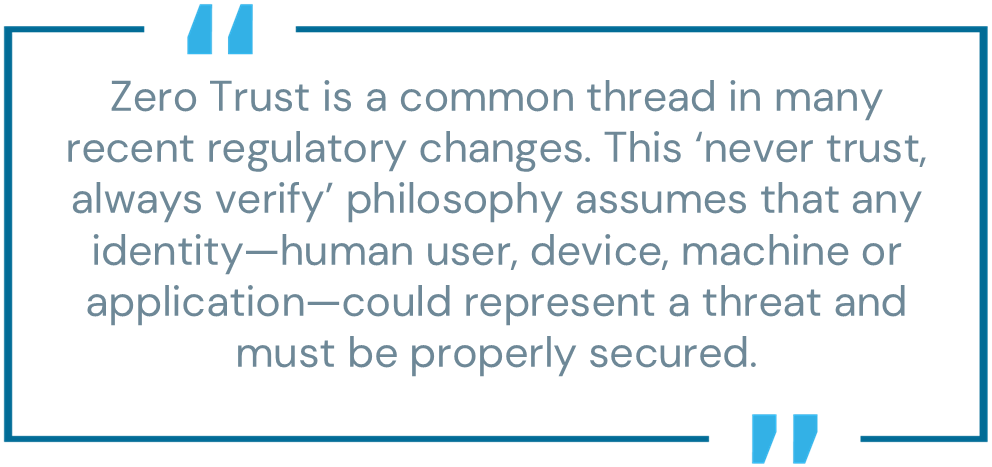
In today’s rapidly evolving global regulatory landscape, new technologies, environments and threats are heightening cybersecurity and data privacy concerns. In the last year, governing bodies have taken significant steps to enact stricter compliance measures—and more than ever, they are focusing on identity-related threats. Some notable changes include:
- The National Institute of Standards and Technology (NIST) released its revised NIST Cybersecurity Framework, emphasizing supply chain risk management and AI implementation guidelines.
- The European Union’s updated NIS2 Directive took effect, extending its reach across industries and introducing higher penalties for non-compliance.
- Data protection rules continued to tighten around the world. In the U.S., the updated California Privacy Rights Act (CPRA) gives consumers increased data privacy rights and introduces new rules for automated decision-making systems. Meanwhile, countries such as Brazil and India introduced laws broadly aligned with the EU General Data Protection Act (GDPR) to ensure global data transfer and protection.
- As cloud adoption continues to surge, the U.S. Federal Risk and Authorization Management Program (FedRAMP) and the European Union Agency for Cybersecurity (ENISA) introduced new certification requirements for cloud service providers (CSPs) for securing access to critical government data and systems.
Zero Trust is a common thread in many recent regulatory changes. This “never trust, always verify” philosophy assumes that any identity—human user, device, machine or application—could represent a threat and must be properly secured.
Today, any identity can be configured with thousands of permissions to access services, data and other sensitive resources. This means any identity can become privileged and be exploited to launch attacks or steal confidential data—at any point in time. Consider, for instance, an identity that was authorized and trusted five minutes ago but has just been compromised and can no longer be trusted. To fully embrace Zero Trust, organizations must be able to dynamically secure identities and manage access to their enterprise resources—assessing potential risks in real time and building context into authentication mechanisms.
For many, identity security is emerging as a way to overcome traditional challenges, such as rigid access policies, static permissions and a lack of real time threat detection, and align their security postures with evolving compliance requirements. Identity security tools enforce zero standing privileges (ZSP) by eliminating persistent access and granting temporary, just-in-time (JIT) access based on the least privilege principle. This minimizes the attack surface by dynamically elevating and revoking user privileges as needed. With identity security, organizations can navigate regulatory uncertainty and tackle identity-centric risks throughout the continuous, dynamic compliance voyage.

Charting a Course to Meet Compliance and Audit with Identity Security
Compliance is not just about how consumer data is stored but also how it’s collected, processed, and used. In fact, compliance is no longer just about data. Regulators, auditors and even board members are focusing on resilience—probing organizations’ ability to prevent, withstand and recover from cyberattacks and outages. Now, compliance and security are inextricably connected, underscoring the need for an integrated strategy and an identity security “compass” to help organizations chart their course.
Sharpening Strategic Advantage
The truth is that even the most compliant organizations get breached. Savvy security leaders recognize this and no longer view compliance as a tick-box exercise. Instead, they approach regulatory mandates as a strategic way to enforce broad, risk-mitigating controls that, most importantly, secure and advance the business and, consequently, meet necessary compliance demands.
A great example of this is financial institutions subject to the Sarbanes-Oxley Act (SOX). Yes, they’re required to have effective internal controls over financial reporting, but they also view identity-centric controls like privileged access management (PAM) as critical for building client trust. By ensuring that only authorized individuals have access to privileged accounts and that any changes to data are tracked and audited, financial institutions can effectively demonstrate their commitment to upholding customer data integrity, protection and reliability—the foundation on which trust is built.
Anticipating Regulatory Tides
Today’s regulatory bodies expect proactive risk management—that’s a given. However, true proactivity means going beyond the baseline requirements of knowing where risk exists and having plans to address it.
Since any identity can become privileged and be exploited to launch attacks or steal confidential data, the challenge is: How do we gain the visibility and control needed to ensure that permissions and entitlements given don’t jeopardize our organization?
Identity security gives organizations a unified view of who has access to what, with capabilities for discovering, adjusting, certifying and revoking access. Empowered, organizations can detect and mitigate risks before they become actual threats. For instance, healthcare providers that face challenges in managing the surge of digital identities and access privileges across their diverse, interconnected systems are turning to identity governance and administration (IGA) to streamline compliance with HIPAA and other stringent industry regulations while demonstrating leadership in patient data protection.
As business accelerates and audit requirements evolve, organizations also need a constant view of their progress toward regulatory requirements and where gaps exist. They must be able to show auditors and the Board which data (and associated identities) is under control and which data (and associated identities) must still be tackled and brought under control. Identity security allows organizations to continuously assess their controls, prioritize risk-mitigation efforts for specific areas and better predict where auditors may focus next.
Building Trust on the Open Sea of Digital Interactions
Trust is paramount in the digital economy. A single incident can damage a business’s reputation and relationships, as seen with recent high-profile breaches. What’s more, crippling regulatory fines and legal settlements can be huge impediments to future growth and transformation.
Identity security can help companies build and strengthen trust by enforcing transparency and accountability while demonstrating responsible data stewardship to meet GDPR and other major compliance regulations.
Navigating the Future of Compliance with Identity Security
Sailing Smoothly on Autopilot
Many companies have historically struggled to manage entitlements and meet compliance with data privacy and cybersecurity regulations. Despite the growing prevalence of intelligent automation, many continue to rely on disjointed, manual processes to onboard and offboard users and oversee their evolving access rights. These methods are inefficient at best and error-prone at worst—hampering visibility and control, hindering IT service agility and heightening risk.
Identity security solutions can help streamline and automate manually intensive, error-prone administrative processes, ensuring that all access rights are properly assigned and continually certified. These tools can also play a “co-pilot” role by automating decision-making based on contextual data about users. And when it comes to the often-dreaded reporting process, they provide in-depth analytics, and audit trails to help teams easily identify potential compliance issues and streamline reports.
Adapting to Changing Conditions with Dynamic Controls
The regulatory landscape is much like the ocean, constantly moving and changing and sometimes catching travelers off guard. That’s why static security measures tend to fail under pressure, and organizations are increasingly seeking dynamic identity security controls—for instance, for authentication that can adjust requirements based on the specific situation and adapt to threats in real time.
Staying Vigilant on the High Seas
The continuous compliance journey requires endless vigilance (read: continuous monitoring and attestation). Limiting the scope of what must be watched makes this much easier to accomplish. Identity security solutions help by applying the principles of least privilege across today’s highly distributed, hybrid IT environments. Removing unnecessary privileged accounts and high-risk access and tightly controlling what users can do in any given session can significantly shrink the attack surface—and the associated compliance burden. With a clear, consolidated view, organizations can catch issues earlier, confidently demonstrate compliance and gain insights for strategic business decisions.
Steering Toward Compliance Leadership with Identity Security
In today’s regulatory environment, the only constant is change. Organizations that are prepared to navigate murky and uncertain waters—and armed with a reliable map for the journey—will not just survive but thrive. By embracing identity security as part of a complete Zero Trust access approach, organizations can holistically satisfy compliance while strengthening their security posture to gain a competitive edge.
Barak Feldman is senior vice president of Sales Strategy and Excellence at CyberArk.



















